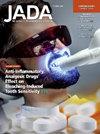牙科身体畸形障碍患者的治疗方法:系统综述。
IF 3.1
2区 医学
Q1 DENTISTRY, ORAL SURGERY & MEDICINE
引用次数: 0
摘要
背景:身体畸形障碍(BDD),其特征是对外观缺陷的强迫性关注,约占总人口的0.7%至2.4%,其中与牙齿相关的问题占20%。牙医在临床实践中可以在识别和管理患者的护理中发挥作用。作者旨在评估BDD在牙科患者中的患病率,并描述受影响患者的特征和可用的诊断工具。综述的研究类型:作者遵循系统综述和荟萃分析清单的首选报告项目,并于2024年7月4日在PubMed, Web of Science和Scopus中进行了搜索。纳入标准包括成年BDD患者和与牙科医学相关的研究。排除标准包括这种疾病不是主要焦点的研究和涉及儿童的研究。结果:401篇文献中,8篇符合纳入标准。在这些研究中,有4项研究表明,牙科机构的BDD患者主要是单身,有3项研究报告了女性患者的较高患病率。结论和实际意义:由于口腔卫生保健专业人员和患者的伦理和安全问题,例如预防过度治疗和对治疗结果的不满,对寻求美容手术的患者准确识别BDD至关重要。本系统综述的结果使口腔卫生保健提供者能够深入了解患者特征和筛查工具,以促进识别,知情决策和减轻潜在的医学法律风险。本文章由计算机程序翻译,如有差异,请以英文原文为准。
Approach to patients with body dysmorphic disorder in dentistry
Background
Body dysmorphic disorder (BDD), characterized by an obsessive focus on perceived flaws in appearance and affects approximately 0.7% through 2.4% of the general population, with dental-related concerns accounting for 20% of cases. Dentists in clinical practice could play a role in identifying and managing the care of patients with this condition. The authors aimed to evaluate the prevalence of BDD in dental patients and describe the characteristics of affected patients and available diagnostic tools.
Types of Studies Reviewed
The authors followed the Preferred Reporting Items for Systematic reviews and Meta-Analyses checklist and conducted searches in PubMed, Web of Science, and Scopus on July 4, 2024. Inclusion criteria included studies on adult patients with BDD and relevant to dental medicine. Exclusion criteria included studies in which this disorder was not the primary focus and studies involving children.
Results
Of 401 articles retrieved, 8 met the inclusion criteria. Among these, in 4 studies researchers indicated that patients with BDD in dental settings are predominantly single and in 3 studies a higher prevalence in female patients was reported.
Conclusions and Practical Implications
Accurate identification of BDD in patients seeking esthetic procedures is essential due to ethical and safety concerns for both oral health care professionals and patients, such as prevention of overtreatment and dissatisfaction with treatment outcomes. The results of this systematic review equip oral health care providers with insights into patient characteristics and screening tools to facilitate identification, informed decision making, and mitigation of potential medicolegal risks.
求助全文
通过发布文献求助,成功后即可免费获取论文全文。
去求助
来源期刊

Journal of the American Dental Association
医学-牙科与口腔外科
CiteScore
5.30
自引率
10.30%
发文量
221
审稿时长
34 days
期刊介绍:
There is not a single source or solution to help dentists in their quest for lifelong learning, improving dental practice, and dental well-being. JADA+, along with The Journal of the American Dental Association, is striving to do just that, bringing together practical content covering dentistry topics and procedures to help dentists—both general dentists and specialists—provide better patient care and improve oral health and well-being. This is a work in progress; as we add more content, covering more topics of interest, it will continue to expand, becoming an ever-more essential source of oral health knowledge.
 求助内容:
求助内容: 应助结果提醒方式:
应助结果提醒方式:


